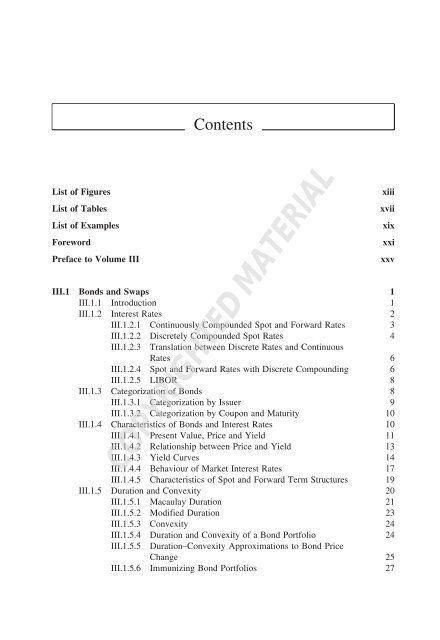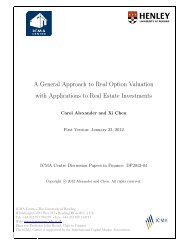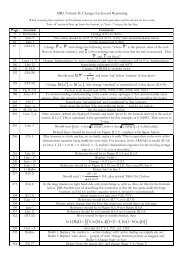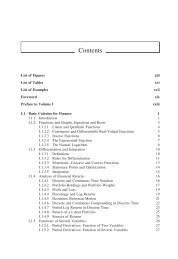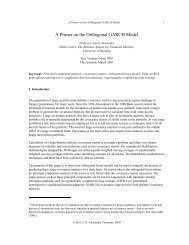Contents - Professor Carol Alexander
Contents - Professor Carol Alexander
Contents - Professor Carol Alexander
Create successful ePaper yourself
Turn your PDF publications into a flip-book with our unique Google optimized e-Paper software.
<strong>Contents</strong><br />
List of Figures<br />
List of Tables<br />
List of Examples<br />
Foreword<br />
Preface to Volume III<br />
III.1 Bonds and Swaps 1<br />
III.1.1 Introduction 1<br />
III.1.2 Interest Rates 2<br />
III.1.2.1 Continuously Compounded Spot and Forward Rates 3<br />
III.1.2.2 Discretely Compounded Spot Rates 4<br />
III.1.2.3<br />
xiii<br />
xvii<br />
xix<br />
xxi<br />
xxv<br />
Translation between Discrete Rates and Continuous<br />
Rates 6<br />
III.1.2.4 Spot and Forward Rates with Discrete Compounding 6<br />
III.1.2.5 LIBOR 8<br />
III.1.3 Categorization of Bonds 8<br />
III.1.3.1 Categorization by Issuer 9<br />
III.1.3.2 Categorization by Coupon and Maturity 10<br />
III.1.4 Characteristics of Bonds and Interest Rates 10<br />
III.1.4.1 Present Value, Price and Yield 11<br />
III.1.4.2 Relationship between Price and Yield 13<br />
III.1.4.3 Yield Curves 14<br />
COPYRIGHTED MATERIAL<br />
III.1.4.4 Behaviour of Market Interest Rates 17<br />
III.1.4.5 Characteristics of Spot and Forward Term Structures 19<br />
III.1.5 Duration and Convexity 20<br />
III.1.5.1 Macaulay Duration 21<br />
III.1.5.2 Modified Duration 23<br />
III.1.5.3 Convexity 24<br />
III.1.5.4 Duration and Convexity of a Bond Portfolio 24<br />
III.1.5.5 Duration–Convexity Approximations to Bond Price<br />
Change 25<br />
III.1.5.6 Immunizing Bond Portfolios 27
viii<br />
<strong>Contents</strong><br />
III.1.6 Bonds with Semi-Annual and Floating Coupons 28<br />
III.1.6.1 Semi-Annual and Quarterly Coupons 29<br />
III.1.6.2 Floating Rate Notes 31<br />
III.1.6.3 Other Floaters 33<br />
III.1.7 Forward Rate Agreements and Interest Rate Swaps 33<br />
III.1.7.1 Forward Rate Agreements 34<br />
III.1.7.2 Interest Rate Swaps 35<br />
III.1.7.3 Cash Flows on Vanilla Swaps 36<br />
III.1.7.4 Cross-Currency Swaps 38<br />
III.1.7.5 Other Swaps 40<br />
III.1.8 Present Value of Basis Point 41<br />
III.1.8.1 PV01 and Value Duration 41<br />
III.1.8.2 Approximations to PV01 44<br />
III.1.8.3 Understanding Interest Rate Risk 45<br />
III.1.9 Yield Curve Fitting 48<br />
III.1.9.1 Calibration Instruments 48<br />
III.1.9.2 Bootstrapping 49<br />
III.1.9.3 Splines 51<br />
III.1.9.4 Parametric Models 52<br />
III.1.9.5<br />
Case Study: Statistical Properties of Forward LIBOR<br />
Rates 53<br />
III.1.10 Convertible Bonds 59<br />
III.1.10.1 Characteristics of Convertible Bonds 60<br />
III.1.10.2 Survey of Pricing Models for Convertible Bonds 61<br />
III.1.11 Summary and Conclusions 62<br />
III.2 Futures and Forwards 65<br />
III.2.1 Introduction 65<br />
III.2.2 Characteristics of Futures and Forwards 68<br />
III.2.2.1 Interest Rate and Swap Futures 68<br />
III.2.2.2 Bond Futures 70<br />
III.2.2.3 Currency Futures and Forwards 73<br />
III.2.2.4 Energy and Commodity Futures 74<br />
III.2.2.5 Stock Futures and Index Futures 79<br />
III.2.2.6 Exchange Traded Funds and ETF Futures 80<br />
III.2.2.7 New Futures Markets 82<br />
III.2.3 Theoretical Relationships between Spot, Forward and Futures 87<br />
III.2.3.1 No Arbitrage Pricing 87<br />
III.2.3.2 Accounting for Dividends 88<br />
III.2.3.3 Dividend Risk and Interest Rate Risk 90<br />
III.2.3.4 Currency Forwards and the Interest Rate Differential 91<br />
III.2.3.5 No Arbitrage Prices for Forwards on Bonds 92<br />
III.2.3.6<br />
Commodity Forwards, Carry Costs and Convenience<br />
Yields 93<br />
III.2.3.7 Fair Values of Futures and Spot 94<br />
III.2.4 The Basis 95<br />
III.2.4.1 No Arbitrage Range 95
<strong>Contents</strong><br />
ix<br />
III.2.4.2 Correlation between Spot and Futures Returns 97<br />
III.2.4.3 Introducing Basis Risk 98<br />
III.2.4.4 Basis Risk in Commodity Markets 100<br />
III.2.5 Hedging with Forwards and Futures 101<br />
III.2.5.1 Traditional ‘Insurance’ Approach 102<br />
III.2.5.2 Mean–Variance Approach 104<br />
III.2.5.3 Understanding the Minimum Variance Hedge Ratio 106<br />
III.2.5.4 Position Risk 108<br />
III.2.5.5 Proxy Hedging 110<br />
III.2.5.6 Basket Hedging 111<br />
III.2.5.7 Performance Measures for Hedged Portfolios 112<br />
III.2.6 Hedging in Practice 113<br />
III.2.6.1 Hedging Forex Risk 113<br />
III.2.6.2 Hedging International Stock Portfolios 114<br />
III.2.6.3 Case Study: Hedging an Energy Futures Portfolio 118<br />
III.2.6.4 Hedging Bond Portfolios 124<br />
III.2.7 Using Futures for Short Term Hedging 126<br />
III.2.7.1 Regression Based Minimum Variance Hedge Ratios 127<br />
III.2.7.2 Academic Literature on Minimum Variance Hedging 129<br />
III.2.7.3 Short Term Hedging in Liquid Markets 131<br />
III.2.8 Summary and Conclusions 133<br />
III.3 Options 137<br />
III.3.1 Introduction 137<br />
III.3.2 Foundations 139<br />
III.3.2.1 Arithmetic and Geometric Brownian Motion 140<br />
III.3.2.2 Risk Neutral Valuation 142<br />
III.3.2.3 Numeraire and Measure 144<br />
III.3.2.4 Market Prices and Model Prices 146<br />
III.3.2.5 Parameters and Calibration 147<br />
III.3.2.6 Option Pricing: Review of the Binomial Model 148<br />
III.3.3 Characteristics of Vanilla Options 151<br />
III.3.3.1 Elementary Options 152<br />
III.3.3.2 Put–Call Parity 153<br />
III.3.3.3 Moneyness 154<br />
III.3.3.4 American Options 155<br />
III.3.3.5 Early Exercise Boundary 156<br />
III.3.3.6 Pricing American Options 158<br />
III.3.4 Hedging Options 159<br />
III.3.4.1 Delta 159<br />
III.3.4.2 Delta Hedging 161<br />
III.3.4.3 Other Greeks 161<br />
III.3.4.4 Position Greeks 163<br />
III.3.4.5 Delta–Gamma Hedging 164<br />
III.3.4.6 Delta–Gamma–Vega Hedging 165<br />
III.3.5 Trading Options 167<br />
III.3.5.1 Bull Strategies 167
x<br />
<strong>Contents</strong><br />
III.3.5.2 Bear Strategies 168<br />
III.3.5.3 Other Spread Strategies 169<br />
III.3.5.4 Volatility Strategies 170<br />
III.3.5.5 Replication of P&L Profiles 172<br />
III.3.6 The Black–Scholes–Merton Model 173<br />
III.3.6.1 Assumptions 174<br />
III.3.6.2 Black–Scholes–Merton PDE 175<br />
III.3.6.3 Is the Underlying the Spot or the Futures Contract 176<br />
III.3.6.4 Black–Scholes–Merton Pricing Formula 178<br />
III.3.6.5 Interpretation of the Black–Scholes–Merton Formula 180<br />
III.3.6.6 Implied Volatility 183<br />
III.3.6.7 Adjusting BSM Prices for Stochastic Volatility 183<br />
III.3.7 The Black–Scholes–Merton Greeks 186<br />
III.3.7.1 Delta 187<br />
III.3.7.2 Theta and Rho 188<br />
III.3.7.3 Gamma 189<br />
III.3.7.4 Vega, Vanna and Volga 190<br />
III.3.7.5 Static Hedges for Standard European Options 193<br />
III.3.8 Interest Rate Options 194<br />
III.3.8.1 Caplets and Floorlets 195<br />
III.3.8.2 Caps, Floors and their Implied Volatilities 196<br />
III.3.8.3 European Swaptions 198<br />
III.3.8.4 Short Rate Models 199<br />
III.3.8.5 LIBOR Model 201<br />
III.3.8.6<br />
Case Study: Application of PCA to LIBOR Model<br />
Calibration 203<br />
III.3.9 Pricing Exotic Options 207<br />
III.3.9.1 Pay-offs to Exotic Options 208<br />
III.3.9.2 Exchange Options and Best/Worst of Two Asset Options 209<br />
III.3.9.3 Spread Options 211<br />
III.3.9.4 Currency Protected Options 213<br />
III.3.9.5 Power Options 214<br />
III.3.9.6 Chooser Options and Contingent Options 214<br />
III.3.9.7 Compound Options 216<br />
III.3.9.8 Capped Options and Ladder Options 216<br />
III.3.9.9 Look-Back and Look-Forward Options 218<br />
III.3.9.10 Barrier Options 219<br />
III.3.9.11 Asian Options 221<br />
III.3.10 Summary and Conclusions 224<br />
III.4 Volatility 227<br />
III.4.1 Introduction 227<br />
III.4.2 Implied Volatility 231<br />
III.4.2.1 ‘Backing Out’ Implied Volatility from a Market Price 231<br />
III.4.2.2 Equity Index Volatility Skew 233<br />
III.4.2.3 Smiles and Skews in Other Markets 236
<strong>Contents</strong><br />
xi<br />
III.4.2.4 Term Structures of Implied Volatilities 238<br />
III.4.2.5 Implied Volatility Surfaces 239<br />
III.4.2.6 Cap and Caplet Volatilities 240<br />
III.4.2.7 Swaption Volatilities 242<br />
III.4.3 Local Volatility 243<br />
III.4.3.1 Forward Volatility 244<br />
III.4.3.2 Dupire’s Equation 245<br />
III.4.3.3 Parametric Models of Local Volatility 248<br />
III.4.3.4 Lognormal Mixture Diffusion 249<br />
III.4.4 Modelling the Dynamics of Implied Volatility 255<br />
III.4.4.1 Sticky Models 255<br />
III.4.4.2 Case Study I: Principal Component Analysis of Implied<br />
Volatilities 257<br />
III.4.4.3 Case Study II: Modelling the ATM Volatility–Index<br />
Relationship 261<br />
III.4.4.4 Case Study III: Modelling the Skew Sensitivities 264<br />
III.4.4.5<br />
Applications of Implied Volatility Dynamics to Hedging<br />
Options 265<br />
III.4.5 Stochastic Volatility Models 268<br />
III.4.5.1 Stochastic Volatility PDE 269<br />
III.4.5.2 Properties of Stochastic Volatility 271<br />
III.4.5.3 Model Implied Volatility Surface 275<br />
III.4.5.4 Model Local Volatility Surface 277<br />
III.4.5.5 Heston Model 278<br />
III.4.5.6 GARCH Diffusions 280<br />
III.4.5.7 CEV and SABR Models 285<br />
III.4.5.8 Jumps in Prices and in Stochastic Volatility 287<br />
III.4.6 Scale Invariance and Hedging 289<br />
III.4.6.1 Scale Invariance and Change of Numeraire 291<br />
III.4.6.2 Definition of Scale Invariance 291<br />
III.4.6.3 Scale Invariance and Homogeneity 292<br />
III.4.6.4 Model Free Price Hedge Ratios 294<br />
III.4.6.5 Minimum Variance Hedging 297<br />
III.4.6.6 Minimum Variance Hedge Ratios in Specific Models 299<br />
III.4.6.7 Empirical Results 300<br />
III.4.7 Trading Volatility 303<br />
III.4.7.1 Variance Swaps and Volatility Swaps 304<br />
III.4.7.2 Trading Forward Volatility 306<br />
III.4.7.3 Variance Risk Premium 307<br />
III.4.7.4 Construction of a Volatility Index 308<br />
III.4.7.5 Effect of the Skew 309<br />
III.4.7.6 Term Structures of Volatility Indices 309<br />
III.4.7.7 Vix and Other Volatility Indices 311<br />
III.4.7.8 Volatility Index Futures 312<br />
III.4.7.9 Options on Volatility Indices 314<br />
III.4.7.10 Using Realized Volatility Forecasts to Trade Volatility 315<br />
III.4.8 Summary and Conclusion 316
xii<br />
<strong>Contents</strong><br />
III.5 Portfolio Mapping 321<br />
III.5.1 Introduction 321<br />
III.5.2 Risk Factors and Risk Factor Sensitivities 323<br />
III.5.2.1 Interest Rate Sensitive Portfolios 323<br />
III.5.2.2 Equity Portfolios 324<br />
III.5.2.3 International Exposures 327<br />
III.5.2.4 Commodity Portfolios 328<br />
III.5.2.5 Options Portfolios 328<br />
III.5.2.6 Orthogonalization of Risk Factors 330<br />
III.5.2.7 Nominal versus Percentage Risk Factors and Sensitivities 330<br />
III.5.3 Cash Flow Mapping 332<br />
III.5.3.1 Present Value Invariant and Duration Invariant Maps 332<br />
III.5.3.2 PV01 Invariant Cash Flow Maps 333<br />
III.5.3.3 Volatility Invariant Maps 334<br />
III.5.3.4 Complex Cash Flow Maps 336<br />
III.5.4 Applications of Cash Flow Mapping to Market Risk Management 337<br />
III.5.4.1 Risk Management of Interest Rate Sensitive Portfolios 337<br />
III.5.4.2 Mapping Portfolios of Commodity Futures 338<br />
III.5.5 Mapping an Options Portfolio to Price Risk Factors 340<br />
III.5.5.1 Taylor Expansions 341<br />
III.5.5.2 Value Delta and Value Gamma 342<br />
III.5.5.3 Delta–Gamma Approximation: Single Underlying 344<br />
III.5.5.4 Effect of Gamma on Portfolio Risk 346<br />
III.5.5.5 Price Beta Mapping 347<br />
III.5.5.6 Delta–Gamma Approximation: Several Underlyings 349<br />
III.5.5.7 Including Time and Interest Rates Sensitivities 351<br />
III.5.6 Mapping Implied Volatility 353<br />
III.5.6.1 Vega Risk in Options Portfolios 353<br />
III.5.6.2 Second Order Approximations: Vanna and Volga 354<br />
III.5.6.3 Vega Bucketing 355<br />
III.5.6.4 Volatility Beta Mapping 356<br />
III.5.7 Case Study: Volatility Risk in FTSE 100 Options 357<br />
III.5.7.1 Estimating the Volatility Betas 357<br />
III.5.7.2 Model Risk of Volatility Mapping 360<br />
III.5.7.3 Mapping to Term Structures of Volatility Indices 361<br />
III.5.7.4 Using PCA with Volatility Betas 361<br />
III.5.8 Summary and Conclusions 364<br />
References 367<br />
Index 377


